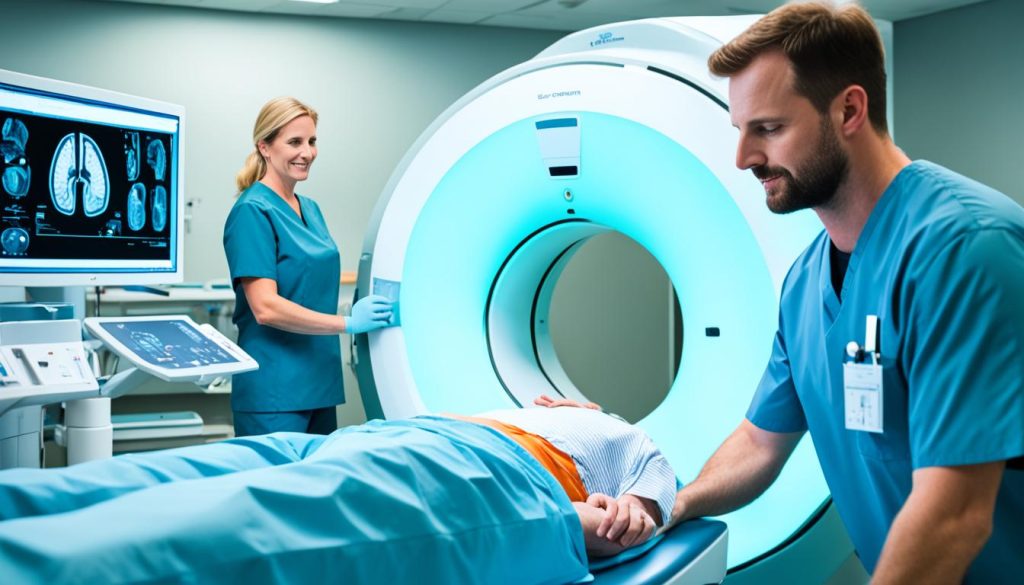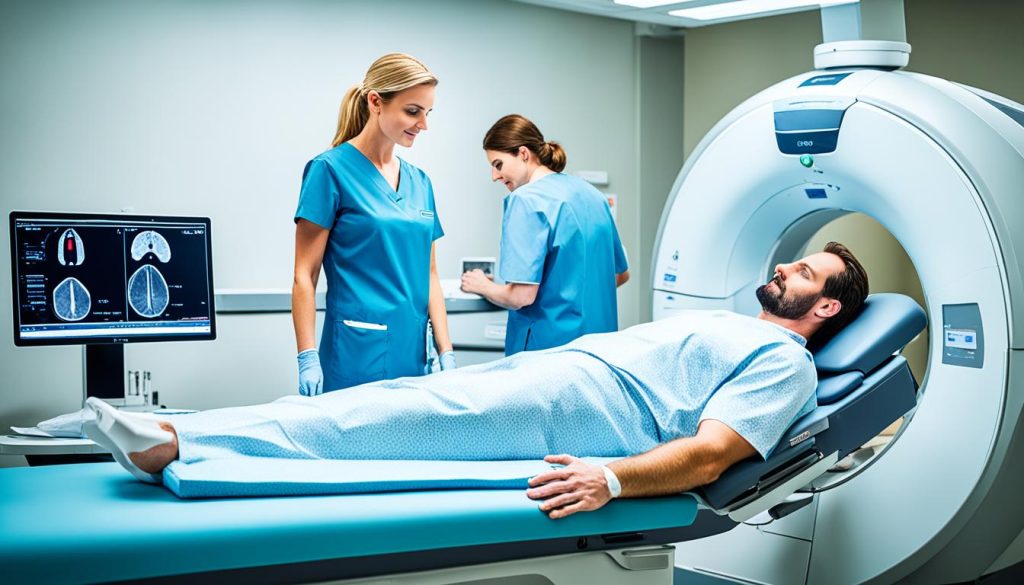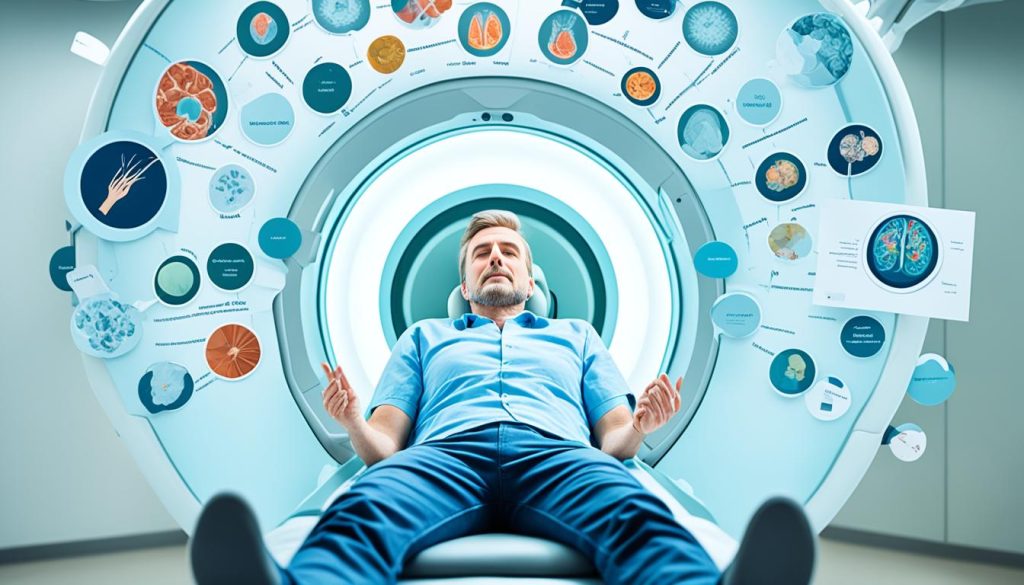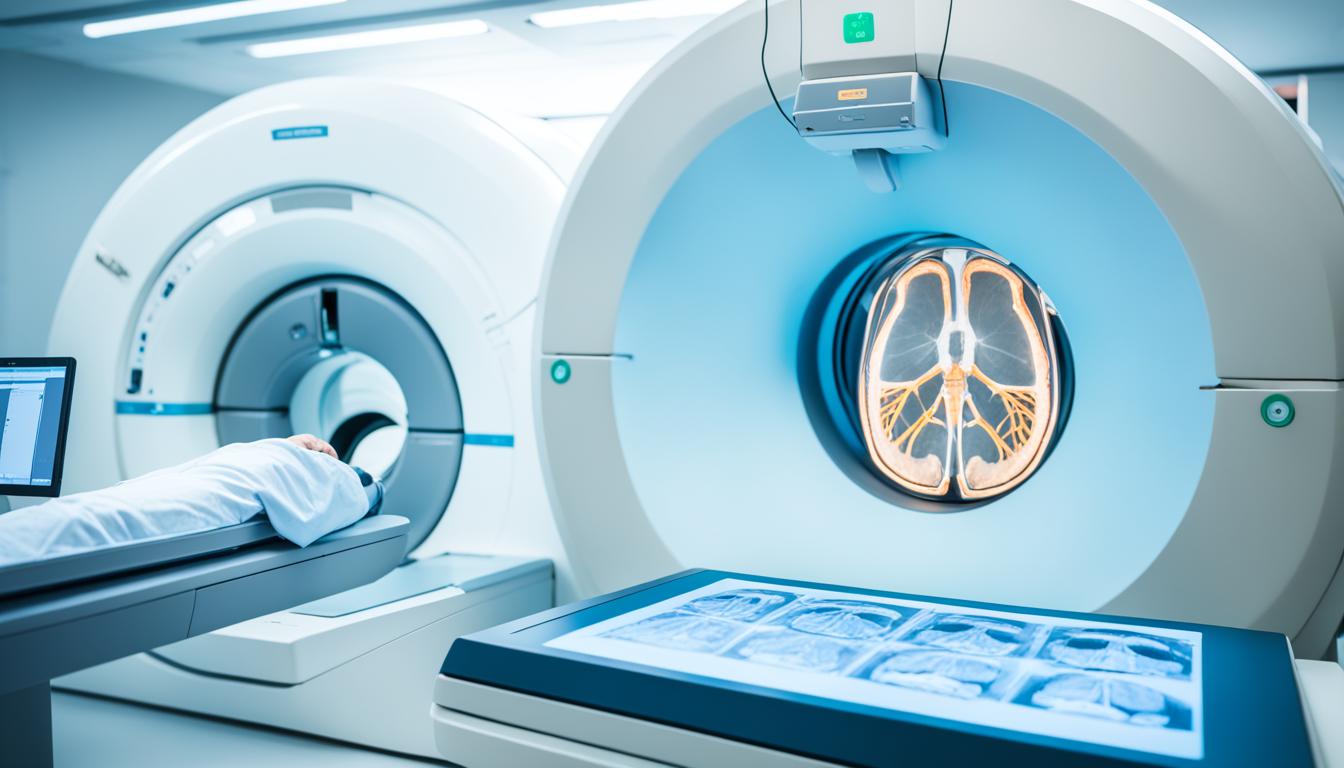A CT (computed tomography) scan and an MRI (magnetic resonance imaging) are both medical imaging methods used for diagnosing and staging cancer, as well as other medical conditions. A CT scan uses X-rays to create detailed images of organs, bones, and tissues, while an MRI uses radio waves and a powerful magnet to generate pictures. CT scans are often the first choice for imaging, as they can provide an image of almost the entire body in a few seconds, making them effective for diagnosing and monitoring cancer, as well as other conditions like bone fractures and internal bleeding. MRI scans excel in detecting certain diseases that may not be visible on a CT scan, such as prostate cancer, uterine cancer, and certain liver cancers. They are also used for diagnosing soft tissue or joint injuries, as well as brain and heart conditions. Both CT and MRI scans have advantages and disadvantages, including differences in radiation exposure and the need for contrast dye. The choice between a CT scan and an MRI depends on the specific medical situation and the area of the body being examined.
What is the Difference Between CT Scan and MRI?
CT scans and MRIs are two different medical imaging techniques that are used to diagnose and visualize different aspects of the body. Understanding how these imaging methods work can help you appreciate their unique capabilities and applications.
CT Scan
CT scans, also known as computed tomography scans, utilize X-rays to create detailed cross-sectional images of the body. During a CT scan, the patient lies on a table that moves through a scanning ring. Meanwhile, the X-ray machine rotates around them, capturing data from different angles. These X-ray images are then processed by a computer to generate comprehensive and detailed images of the body’s internal structures.
MRI Process
In contrast, MRIs, or magnetic resonance imaging scans, rely on a strong magnetic field and radio waves to produce images. During an MRI, the person lies on a table that moves into a doughnut-shaped device known as the MRI scanner. Once inside the scanner, the magnetic field and radio waves cause the hydrogen atoms in the body’s tissues to emit signals. These signals are used to create highly detailed images of the body’s organs, soft tissues, joints, and even the brain and heart.

Both CT scans and MRIs provide valuable information for medical professionals to diagnose and treat various conditions. CT scans excel in capturing images of bones, organs, and tissues, making them effective for diagnosing cancer, bone fractures, and internal bleeding. They are faster and more suitable for emergency situations, as they can provide detailed images of the entire body in just a few seconds.
On the other hand, MRIs offer exceptional clarity and precision in visualizing soft tissues and organs. They are particularly useful in identifying diseases that may not be clearly visible on a CT scan, such as certain types of cancers, joint issues, and brain conditions. Additionally, MRIs do not expose patients to ionizing radiation, making them a safer option for long-term monitoring or for patients who may be more sensitive to radiation.
Understanding the fundamental processes behind CT scans and MRIs highlights their distinct capabilities and advantages. Medical professionals carefully choose the most suitable imaging method based on the specific medical situation, the area of the body being examined, and the benefits and risks associated with each technique.
Advantages of CT Scans
CT scans offer several advantages in medical imaging. Their speed and ability to provide comprehensive body images in just a few seconds make them a valuable tool for diagnosing and staging cancer, monitoring treatment efficacy, and detecting metastases. CT scans are also effective in imaging bone fractures, internal bleeding, blood clots, spinal injuries, and brain injuries. Additionally, they are widely accessible and more cost-effective compared to MRI scans, making them a practical choice for many patients. In emergency situations, CT scans play a crucial role in enabling faster diagnosis and prompt treatment.
One of the key advantages of CT scans is their speed. By capturing detailed images of the body in mere seconds, they significantly reduce the time required for a comprehensive diagnosis. This speed is particularly important in emergency situations, where every second counts. With the ability to quickly identify and evaluate injuries such as bone fractures, internal bleeding, and blood clots, CT scans enable medical professionals to make immediate treatment decisions.
When it comes to cancer diagnosis and staging, CT scans excel at providing detailed images that help determine the extent of the disease and guide appropriate treatment plans. They can detect metastases, which are critical in deciding the most suitable approach for treating cancer. Additionally, CT scans are often used to monitor the effectiveness of ongoing cancer treatments and assess any changes or progression of the disease.
CT scans are also advantageous in imaging spinal and brain injuries. They can accurately diagnose spinal fractures, ligament tears, and disc herniations, enabling prompt treatment and better patient outcomes. In the case of brain injuries, CT scans are efficient in detecting bleeding, swelling, or other abnormalities that require immediate medical attention.
Advantages of CT Scans at a Glance:
- Fast and efficient imaging, providing comprehensive body images in seconds
- Effective for diagnosing and staging cancer, monitoring treatment progress, and detecting metastases
- Accurate imaging of bone fractures, internal bleeding, blood clots, spinal injuries, and brain injuries
- Widely accessible and cost-effective compared to MRI scans
- Crucial in emergency situations, enabling faster diagnosis and treatment decisions

| Advantages of CT Scans | Advantages of MRIs |
|---|---|
| Fast and efficient imaging | Highly detailed images of soft tissues, joints, organs |
| Effective for cancer diagnosis, staging, and treatment monitoring | Detection of diseases not visible on CT scans |
| Accurate imaging of bone fractures, internal bleeding, blood clots, spinal injuries, and brain injuries | No radiation exposure, making them safe for repeated use |
| Widely accessible and cost-effective | Preferable for diagnosing brain and heart conditions, as well as soft tissue injuries |
| Crucial in emergency situations |
Advantages of MRIs
When it comes to medical imaging, MRIs have numerous advantages over CT scans. MRI scans are particularly effective in detecting certain diseases that may not be visible on a CT scan, such as prostate cancer, uterine cancer, and certain types of liver cancers.
One of the key advantages of MRIs is that they provide more detailed images of soft tissues, joints, organs, as well as the brain and heart. This level of detail allows medical professionals to make more accurate diagnoses and better understand the extent of certain conditions.
Unlike CT scans, MRIs do not use ionizing radiation. This is a significant advantage as it eliminates any potential risk of radiation exposure for patients. Instead, MRIs utilize a strong magnetic field and radio waves to generate images, making them a safer option.
MRIs are commonly used for diagnosing a variety of conditions, including soft tissue injuries, joint issues, and diseases of internal organs. They are also instrumental in examining the brain and detecting abnormalities related to stroke or other brain conditions.
Ultimately, the advantages of MRIs lie in their ability to provide detailed imaging, their safety due to the absence of ionizing radiation, and their effectiveness in the diagnosis of specific diseases and conditions. These benefits make MRIs a preferred choice in various medical scenarios.

Benefits of MRIs:
- More detailed images of soft tissues, joints, organs, and the brain
- No ionizing radiation, reducing the risk of radiation exposure
- Effective in detecting specific diseases, such as prostate cancer and uterine cancer
- Used for diagnosing soft tissue injuries, joint issues, and diseases of internal organs
- Can detect abnormalities related to stroke and other brain conditions
These benefits highlight why many individuals and healthcare professionals opt for MRIs over CT scans. The detailed images and enhanced safety of MRIs make them invaluable tools in diagnosing and understanding a wide range of medical conditions.
Conclusion
In conclusion, CT scans and MRIs are both valuable medical imaging methods with their own advantages and uses. CT scans are fast, widely available, and effective for diagnosing and monitoring cancer, as well as detecting bone fractures and internal bleeding. They are often the first choice for imaging. On the other hand, MRIs provide more detailed images and are particularly useful for detecting certain diseases, especially in soft tissues, joints, and organs. They do not use radiation and are preferred for diagnosing brain and heart conditions.
The choice between a CT scan and an MRI depends on the specific medical situation, the area of the body being examined, and the benefits and risks associated with each imaging method. It is important to consult with a medical professional to determine which imaging method is most suitable for individual needs. Whether you choose a CT scan or an MRI, both tests play a crucial role in diagnosing and treating various medical conditions, allowing healthcare professionals to make more informed decisions about patients’ health.
So, when it comes to choosing between a CT scan and an MRI, it’s essential to consider the specific requirements of the medical situation, the areas being examined, and the benefits provided by each imaging method. By understanding the differences between CT scans and MRIs and consulting with a medical professional, you can make an informed decision that will best meet your healthcare needs.
FAQ
1. What is the difference between a CT scan and an MRI?
A CT scan uses X-rays to create images of organs, bones, and tissues, while an MRI uses radio waves and a powerful magnet to produce pictures.
2. What are the advantages of CT scans?
CT scans are fast, widely available, and effective for diagnosing and monitoring cancer, as well as detecting bone fractures and internal bleeding. They are also useful for imaging spinal and brain injuries.
3. What are the advantages of MRIs?
MRIs provide more detailed images of soft tissues, joints, and organs. They are particularly useful for detecting certain diseases, such as prostate cancer, uterine cancer, and certain liver cancers. MRIs do not use radiation and are preferred for diagnosing brain and heart conditions.
4. How do CT scans work?
CT scans take a series of X-ray pictures from different angles, which are then combined to create cross-sectional images of the body. The person lies on a table that moves through a scanning ring, while the X-ray machine rotates around them.
5. How do MRIs work?
MRIs use a strong magnetic field and radio waves to generate images. The person lies on a table that moves into a doughnut-shaped device, and the magnetic field and radio waves cause the hydrogen atoms in the body to produce signals that are used to create detailed images.




